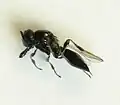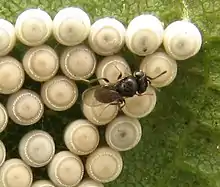| Platygastridae Temporal range: | |
|---|---|
 | |
| Platygaster pupae inside gall | |
| Scientific classification | |
| Domain: | Eukaryota |
| Kingdom: | Animalia |
| Phylum: | Arthropoda |
| Class: | Insecta |
| Order: | Hymenoptera |
| Superfamily: | Platygastroidea |
| Family: | Platygastridae Haliday, 1833 |
| Subfamilies | |
|
Platygastrinae | |
The hymenopteran family Platygastridae (sometimes incorrectly spelled Platygasteridae) is a large group (over 4000 species) of exclusively parasitoid wasps, mostly very small (1–2 mm), black, and shining, with geniculate (elbowed) antennae that have an eight-segmented flagellum. The wings sometimes lack venation, though they may have slight fringes of setae.
The traditional subfamilies are the Platygastrinae and the Sceliotrachelinae. The former subfamily includes some 40 genera, all of which are koinobionts on cecidomyiid flies; the wasp oviposits in the host's egg or early instar larva, and the wasp larva completes development when the host reaches the prepupal or pupal stage. The latter subfamily is much smaller, including some 20 genera, and they typically have the rudiments of a vein in the forewings. They are generally idiobionts, attacking the eggs of either beetles or Hemiptera.
Platygastridae is one of seven extant families in the superfamily Platygastroidea. For a brief period of time, Scelionidae was considered a subfamily of Platygastridae, but the classification has been revised based on molecular and morphological evidence.[1]
Sceliotrachelinae
Sceliotrachelinae includes the genus Aphanomerus, which includes a number of species:[2][3]
- Aphanomerus aureus (Dodd, 1914)
- Aphanomerus bicolor (Perkins, 1905)
- Aphanomerus flavus (Dodd, 1914)
- Aphanomerus niger (Perkins, 1905)
- Aphanomerus nigriceps (Dodd, 1914)
- Aphanomerus pusillus (Perkins, 1905)
- Aphanomerus rufescens (Perkins, 1905)
- Aphanomerus sordidus (Dodd, 1914)
Aphanomerus pusillus, a wasp native to Queensland, Australia, has proven effective against the "pandanus planthopper", or Jamella australiae, which has decimated populations of Pandanus tectorius along the coasts of northern New South Wales and Queensland.[4][5]
 Platygaster sp. female
Platygaster sp. female Platygaster sp. on goldenrod (Solidago)
Platygaster sp. on goldenrod (Solidago) Trissolcus sp. on Chinavia eggs
Trissolcus sp. on Chinavia eggs
References
- ↑ Chen, Huayan; Lahey, Zachary; Talamas, Elijah J.; Valerio, Alejandro A.; Popovici, Ovidiu A.; Musetti, Luciana; Klompen, Hans; Polaszek, Andrew; Masner, Lubomír; Austin, Andrew D.; Johnson, Norman F. (October 2021). "An integrated phylogenetic reassessment of the parasitoid superfamily Platygastroidea (Hymenoptera: Proctotrupomorpha) results in a revised familial classification". Systematic Entomology. 46 (4): 1088–1113. doi:10.1111/syen.12511. ISSN 0307-6970.
- ↑ "Genus: Aphanomerus". Aphanomerus. Retrieved 4 January 2021.
- ↑ Stünzner, Inga (15 December 2020). "Byfield National Park becomes last line of defence against threat to pandanus". ABC News. Australian Broadcasting Corporation. Retrieved 4 January 2021.
- ↑ "The insects killing Fraser Island's pandanus population". Queensland Times. 26 January 2017. Retrieved 4 January 2021.
- ↑ Coghill, Jon (29 October 2015). "Rangers turn to tiny native wasp to save Fraser Island's iconic pandanus population". ABC News. Australian Broadcasting Corporation. Retrieved 4 January 2021.
External links
- a citrus blackfly parasitoid, Amitus hesperidum on the UF / IFAS Featured Creatures Web site
- Baeus latrodecti Dozier on the UF / IFAS Featured Creatures Web site